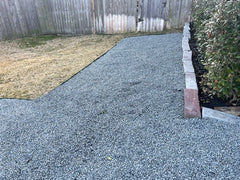
A homeowner was looking to turn a grassy area into additional parking at their residence. By using RutGuard Geocell to hold the gravel in place, structure is added to the material, allowing for less of it to be used while still achieving the same strength as 15" of gravel. This saves big on installation time, material and labor costs up front, as well as reduced maintenance time and money in the long run.




Minimal Prep-Work
The grass was removed and the area was graded as needed. A geotextile fabric was laid directly on top of the prepped surface in order to create a separation layer between the sub base and the geocell. Because of the flexible nature of the geocell panels, very little prep work is required, as the geocell will take the shape of the existing surface layer and will spread the pressures applied laterally. This reduces the amount of pressures that are pushing down into the ground, creating a mattress effect that prohibits the formation of ruts and potholes.
Simple Installation
The 3" RutGuard panels were then measured out to fit the area. Typical expanded panel dimensions are 8' wide by 28' long. The easiest way to get those dimensions are to stake your outside cells using anything on hand - wooden stakes, rebar, sand bags, etc. A helpful tip is that each cell or hole opening within the panel measures 1 foot in width. This is very convenient when staking out your panel before filling.
After the panel is staked out, expand the panels out and fill them with your infill material of choice. Once the panel was filled, the stakes were removed and the vehicle was able to drive, park and even turn around directly atop the surface.
